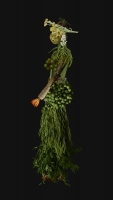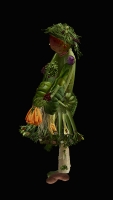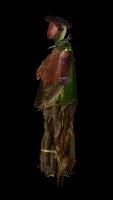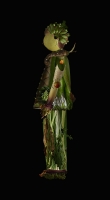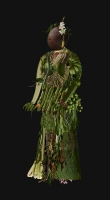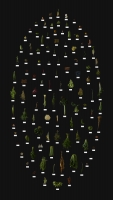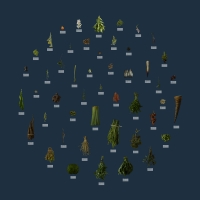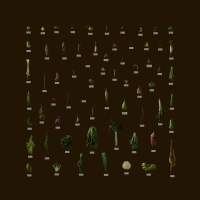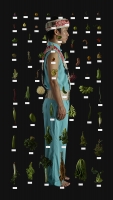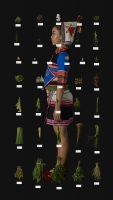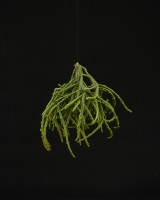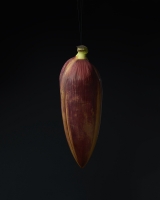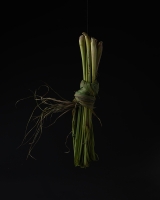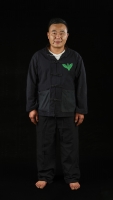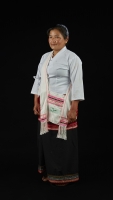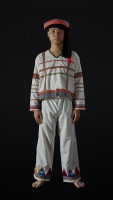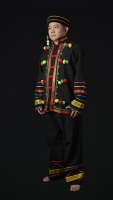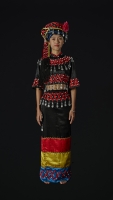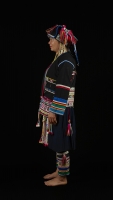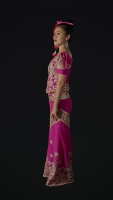video(Click on the title to play):
What makes us:the Lahu nationality
种植与采集:滇南食物影像考察
2021年4月,我从湖北驱车2000公里来到景迈山。
我是一个经常喝茶的人,而且以普洱茶为好,所以作为普洱茶圣地的景迈山在我心里并不陌生,但真正第一次踏入这里,还是给我带来极大的冲击。
我生活的三峡地区也是一个古老的产茶区,其茶事曾被陆羽记入《茶经》,进入山区,大大小小的茶园随处可见,成行种植的茶树被修剪得整整齐齐,成片的茶田不掺一丝杂色,十分的清爽漂亮。
景迈山却是完全不同的场景,所有的茶树都生长在原始森林之中,没有垦荒造出的茶田,咋一看,眼里只有整山的森林,细看才发现,原来茶树都种植在大树之下。把人类的生产活动和自然原始生态融合得如此完美,景迈山人太有智慧了,让我叹服。
这次到景迈山是受到著名策展人、中国文艺乡建的代表人物左靖老师的邀请,去完成一个驻地艺术作品——《什么养成了我们》之景迈山篇,这个作品是我2019年10月在西双版纳完成的同名作品的延续。这样,我在一年中的4月和10月,对云南南部的版纳和景迈山地区展开了人类食物结构的影像调查。
作为一名生物学学科背景的人,我会习惯性地带着生物学眼光观察世界。我选择“食物”这个方向,以“食物链”的眼光,去考察当地的自然与人文。“食物链”是一个生物学专业用语,由英国生态学家埃尔顿(C.S.Eiton)于1927年提出。所谓“食物链”,是指在生态系统内,各种生物之间由于食物而形成的一种联系【1】。人类本是生态系统的普通一员,经过200万年的进化和发展,人类登上了食物链金字塔的顶峰,成为自然生态系统的终端消费者。人类还通过对其它物种的驯化甚至改造,建立了一个人工生态系统,以满足人类对食物的需要。
人类获取食物的方式经历了从“自然采集”到“大规模种植”的演变。和其它地区不同,版纳和景迈山人的食物来源则居于这种演化的中间状态,食物结构和其它地域完全不同:表现为品种总数多、特有品种多、野生品种丰富等特点【2】。
在版纳的作品创作过程中,我以民族为线索,试图探索食物物种和民族的关系。版纳共生活有13个世居民族,我选择了3个民族展开拍摄。包括:版纳人口占比最大的民族傣族、人口最少的民族基诺族和另外还有一个拉祜族。拉祜族是一个和我本人有关的民族,基因检测的结果显示,我的祖源结构包括南方汉族50.3%、北方汉族39.7%、东北亚7.8%,以及2.2%的拉祜族。我拍摄了版纳人用于食用的近200个物种的(食用部位)肖像,还拍摄了这3个民族的男、女性各一人的全身站姿肖像。我请本地的民族专家在我拍摄的这些物种中选出了每个民族的特有常用食物的品种,然后,把这些物种的肖像加上物种标签,拼贴成每个民族一幅的“民族食物物种拼图”。除此之外,我还利用该民族的食物物种肖像,拼出该民族人物肖像,试图讲述“到底什么样的食物养成了我们这些民族”这样一个生物学的故事。
到了景迈山,我试图延续这个故事,但是在这个过程中,我的讲述有了新的变化。因为我发现,由于景迈山地域较小,各民族人群居住地的地理、气候条件相近,各民族人群的食材品种和饮食文化已经相互影响,相互融合,呈现出大一统的形态,在景迈山,分开民族去讲述食物的故事变得没有意义。
但是,这种民族食物形态的融合不正是我们整个地球全球化形态的缩影吗?想到这,景迈山的这个“什么养成了我们”的故事又显出了它特别的魅力。
我在景迈山的创作中,选择了山上所有的4个世居民族展开拍摄,包括傣族、布朗族、哈尼族和佤族。我拍摄了景迈山人用于食用的近200多个物种的肖像,还拍摄了这4个民族的男、女性各一人的全身站姿肖像。对食物品种的挑选区分原则则由民族转到了个体,请被我拍摄的每个人分别挑选出他们常吃的和喜欢吃的食物,最后,我用他们选出的这些食物的肖像,加上生物学标签,拼出他们各自的“食物物种图”,并依据他们各自的人物肖像,用这些食物拼出各自的人物拼像,去讲述景迈山的“到底我们是由什么养成”的故事。
版纳和景迈山的有关食物物种的观察还让我想到了另外一个生物学概念——“生物多样性”,而“食物多样性”正是在人类学意义上“生物多样性”的一种对应。
人类食物结构的单一,而地球人口的爆炸式增长,造成原始生态区域无节制的被“开发”挤占。在我的家乡,往往能看到连片的群山被开垦成了茶园、耕地,这种场景过于司空见惯,不免让人对未来心生不安。
表面上的绿水青山的恢复很容易。在我们内地,几十年的退耕还林卓有成效,山清水秀逐渐回来了。可生物多样性一旦遭受破坏,则将是毁灭性的。像版纳、景迈山这样的地方,成千上万年形成的原始生态,生长的物种数以万计,一旦被开发,即使人类醒悟撤出,恢复生长的也只是茅草、野生香芭蕉、牡竹、紫茎泽兰等这些少数“优势物种”【3】,“物种宝库”的繁荣景象将一去不复返。这样的后果无疑是我们不愿见到的。
未来之路指向何方?
版纳和景迈山人的食物品种及其来源的多样性,以及景迈山生态茶树种植,是人类适应自然的生活方式的体现。这种貌似原始的食物结构和生产方式,会不会正是老天爷留给我们这些“现代人”的一个启示呢?
参考文献
【1】Wikipedia,Food chain,14 September 2021.
【2】许又凯 , 刘宏茂, 2002 . 中国云南热带野生蔬菜 [M] . 北 京: 科学出版社
【3】许再富,西双版纳动植物资源的特点、现状及其保护
作者致谢:本作品在创作过程中得到众多老师朋友的帮助,没有他们就没有这个作品,包括:帮助我辨认食物物种的北京大学顾红雅教授、中科院云南植物所杨湘云教授、中科院西双版纳热带植物园陶国达教授,还有为我思路纠偏的资佰,帮助我现场联系沟通的熊登奎,帮我补拍关键照片的白菜,以及承担助理工作并给我带来无数创作灵感和精神支持的朱红波,感谢他们!
Cultivation and Collection: Imaging Study of Food in Southern Yunnan
In April 2021, I drove 2,000 kilometers from Hubei to Jingmai Mountain.
I am a tea drinker, especially like drinking Pu'er tea. Therefore, as a sacred place for Pu'er tea, Jingmai Mountain is no stranger to me. The first time I stepped into this place, it still brought me a great impact.
The Three Gorges area where I live is also an ancient tea-producing area, and its tea was once recorded in the "Tea Classic" by Lu Yu. When entering the mountains, tea gardens of all sizes can be seen everywhere. The tea trees planted in rows are trimmed neatly, and the tea fields are not mixed with a trace of variegated colors, so they look very refreshing and beautiful.
However, Jingmai Mountain is a completely different scene. All the tea trees here grow in the virgin forest, without the tea fields created by land reclamation. At first glance, there is only a whole forest in my eyes, but when I look closely, it turns out that the tea trees are planted under the big trees. They integrate human production activities with natural primitive ecology so perfectly, I have to admire the wisdom of the people of Jingmai Mountain.
This time, I was invited by Zuo Jing, the famous curator and representative of Chinese Cultural and Artistic Village Construction , to complete a resident art work in Jingmai Mountain-" What Makes Us" of Jingmai Mountain. This work is a continuation of the work of the same name I completed in Xishuangbanna in October 2019. Therefore, in April and October of the year, I carried out an image survey of human food structure in the Xishuangbanna and Jingmai Mountain in southern Yunnan.
As a person with a biological background, I will habitually observe the world from a biological perspective. Therefore, after I chose the direction of "food", I examined the local nature and humanities from the perspective of the "food chain". "Food chain" is a professional term in biology, proposed by British ecologist C.S.Eiton in 1927. "Food chain" refers to a connection formed by food among various organisms in the ecosystem【1】. Human beings are ordinary members of the ecosystem, but after 2 million years of evolution and development, humans have reached the top of the food chain pyramid and eventually become the end consumers of the natural ecosystem. In addition, through the domestication and even transformation of other species, humans have also established an artificial ecosystem to meet their food needs.
Through the ages, the way humans obtain food has evolved from "natural collection" to "large-scale cultivation". But unlike other regions, the food sources of the people in Xishuangbanna and Jingmai Mountain are in the middle of this evolution. The food structure of the two regions is completely different from that of other regions: it is characterized by a large number of species, many endemic species and abundant wild species【2】.
In the creation process in Xishuangbanna, I used ethnicity as a clue to try to explore the relationship between food species and ethnicity. There are 13 ethnic groups living in Xishuangbanna, I chose 3 ethnic groups to start shooting, namely: the Dai ethnic group with the largest population in Xishuangbanna, the Jinuo ethnic group with the smallest population, and another Lahu ethnic group. Among them, the Lahu nationality is an ethnic group related to myself. The results of my genetic test show that my ancestral structure includes 50.3% of the Han nationality in the South, 39.7% of the Han nationality in the North, 7.8% in Northeast Asia, and 2.2% of the Lahu nationality. I took portraits of nearly 200 species (edible parts) used by the Xishuangbanna people for food, as well as full-body standing portraits of men and women from these three ethnic groups. At the same time, I asked local ethnic experts to select the unique and commonly used food varieties of each ethnic group from the species I photographed. Then, I tagged the portraits of these species with species labels, and collaged an "ethnic food species puzzle" for each ethnic group. In addition, I also used the portraits of the food species of the people to piece together portraits of the people of the people. I tried to use the above methods to tell the biological story of "what kind of food has made our peoples?"
After arriving at Jingmai Mountain, I hope to continue this story. But in this process, my narration has undergone new changes. I found that the Jingmai Mountain is relatively small, and the geographical and climatic conditions of the ethnic groups are similar. Therefore, the food varieties and food culture of the ethnic groups have influenced each other and merged with each other, thus presenting a unified form. Therefore, in Jingmai Mountain, it becomes meaningless to tell the story of food by distinguishing different ethnic groups.
However, isn't this integration of the national food form the epitome of the global form of our entire planet? Thinking of this, I believe that the story of " What Makes Us " about Jingmai Mountain has shown its special charm.
In my creation in Jingmai Mountain, I chose all four native peoples on the mountain to shoot, including Dai, Bulang, Hani and Wa. I photographed nearly 200 species used for food by Jingmai Mountain people, and also photographed the whole body standing portrait of one man and one woman from each of the four ethnic groups. The principle of selecting and distinguishing food varieties has changed from nation to individual. Then I asked everyone I photographed to pick out the foods they often eat and like. Finally, I used the portraits of these foods they selected and added biological labels to spell out their own "food species map", and according to their respective portraits, I used these foods to spell out their own characters, telling Jingmai Mountain's story of "What on earth Makes Us?".
In addition, the observation of food species in Xishuangbanna and Jingmai Mountain made me think of another biological concept-"biodiversity". In fact, "food diversity" is exactly a correspondence of "biodiversity" in the anthropological sense.
The singularity of human food structure and the explosive growth of the earth's population have led to the unrestrained "exploitation" of primitive ecological areas. In my hometown, I can often see contiguous mountains that have been reclaimed into tea gardens and cultivated land. This kind of scene is a common occurrence, which inevitably makes people uneasy about the future.
On the one hand, the recovery of green hills and clear waters is easy. For example, in our interior, decades of returning farmland to forests have been fruitful, gradually returning to the original appearance of beautiful mountains and clear waters. On the other hand, once biodiversity is destroyed, it will be devastating. For example, primitive ecology such as Xishuangbanna and Jingmai Mountain have been formed after thousands of years, with tens of thousands of species growing. Once these places are developed, even if human beings wake up in time and no longer destroy the ecology, only a few "dominant species" such as thatch, wild banana, bamboo, and Eupatorium adenophorum can be restored and grown in these places 【3】. This means that the prosperity of the "species treasure house" will be gone forever, and such consequences are undoubtedly undesirable to us.
Where does the future lead?
The diversity of food varieties and sources of the people in Xishuangbanna and Jingmai Mountain, as well as the cultivation of ecological tea trees in Jingmai Mountain, are the embodiment of human adapting to nature's lifestyle. Is this seemingly primitive food structure and production method just an enlightenment left by God to us "modern people"?
references
【1】Wikipedia, Food chain, 14 September 2021.
【2】Xu Youkai, Liu Hongmao, 2002. Tropical wild vegetables in Yunnan, China [M]. Beijing: Science Press
【3】 Xu Zaifu, the characteristics, current situation and protection of Xishuangbanna's animal and plant resources
Acknowledgements:
This work has been helped by many friends in the creation process. Without them, there would be no such work. Mainly includes: Professor Gu Hongya from Peking University, Professor Yang Xiangyun from Yunnan Institute of Botany, Chinese Academy of Sciences, and Professor Tao Guoda from Xishuangbanna Tropical Botanical Garden, Chinese Academy of Sciences,who helped me identify food species. In addition, Zibai helped me to correct my thinking, Xiong Dengkui helped me to communicate on the spot, Baicai helped me take key photos, and Zhu Hongbo worked tirelessly to take on the assistant work and brought me countless creative inspirations and spiritual support, thank them!
